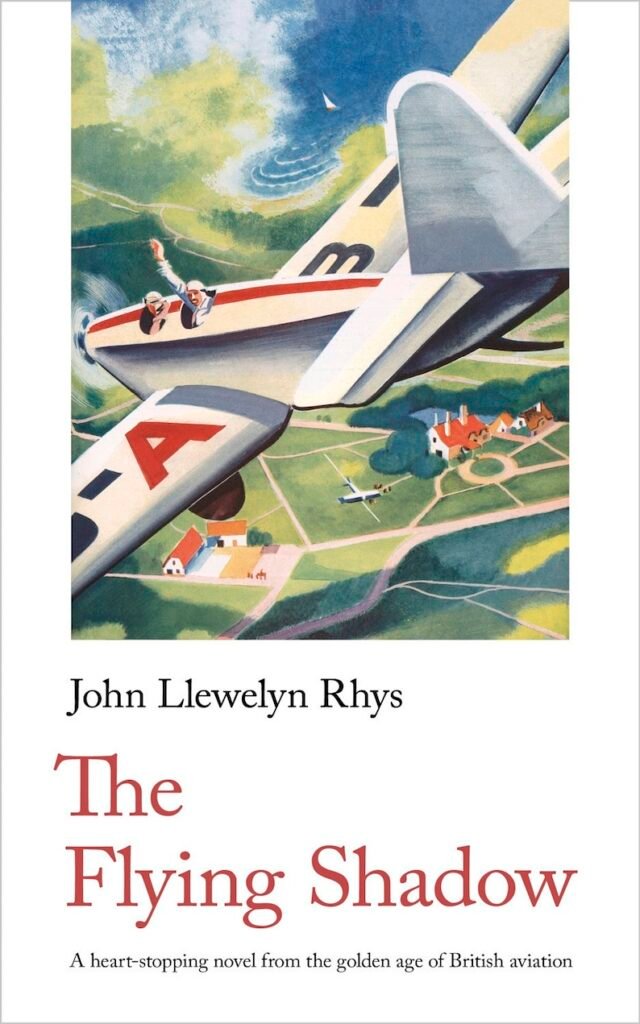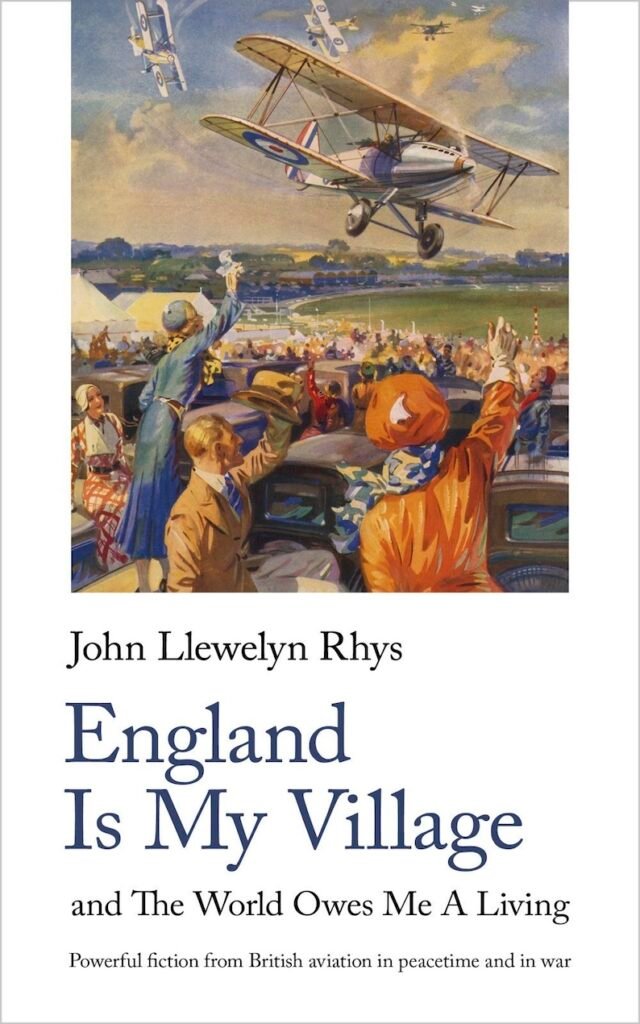
John Llewelyn Rhys, The Flying Shadow (Bath: Handheld Press, 2022).
John Llewelyn Rhys, England Is My Village and The World Owes Me a Living (Bath: Handheld Press, 2022).
John Llewelyn Rees was born on 7 May 1911, got his pilot’s license on 4 July 1934, and was killed in a flying accident on 5 August 1940. Those bare life events hardly stand out among the airminded young men of his generation. But as well as flying, Rees wrote (albeit as John Llewelyn Rhys). His two novels, The Flying Shadow (1936) and The World Owes Me a Living (1939), and a handful of short stories, collected as England is My Village (1941), are suffused with — drenched in, might be a better phrase — a love of flying in all its pleasures and perils. It’s because of this that he bears some comparison as the English-language equivalent of the slightly older Frenchman Antoine de Saint-Exupéry. Certainly, passages like these are rare in contemporary British aviation writing:
Below, the clouds were flat as beaten snow, dazzling white in the brilliant sunshine, undisturbed except for the shadow of the Moth which slid easily, silently, over their even surface. For scores of miles there was no movement, nothing but the sunny emptiness of the sky and the hard, white floor of the clouds, the enormous silence pricked by the stutter of the engine. For the hundredth time the beauty of such a scene hooded his mind, the sense of overwhelming desolation intensifying his realization of individuality. Nothing in the world, he thought, was as lonely as this, no scene so static in beauty, so expansive in monotony.((John Llewelyn Rhys, The Flying Shadow (Bath: Handheld Press, 2022), 39.))
Or:
We flew on for hour after hour, seeing nothing of the earth but the peaks of mountains standing up through the clouds, the only other moving thing our shadow which raced silently beneath us, following every curve of the clouds with effortless grace. Above was the dome of heaven, a nightmare blue except for the blazing ball of the sun, no trace of cloud to break its pitiless emptiness. The one sound in our ears was the roar of the engines mingling with airscrew thrash. We were alone, racing through a dead world.((John Llewelyn Rhys, England Is My Village and The World Owes Me a Living (Bath: Handheld Press, 2022), 237.))
These convey beautifully a sense of the sublime nature of flight, its awesome majesty and terror, intensified at every point by the ever-present possibility of death (possibly a little exaggerated; surely Rhys sensed the ‘inarticulate lust for the blinding novelty of a crash’ among readers just as much as spectators).((Rhys, England is My Village, 122.))
I think the comparison with Saint-Exupéry is fair, though I also don’t think that the novels Rhys did get to write in his foreshortened life are quite on a par with Wind, Sand and Stars or Southern Mail. But even more interesting to me than Rhys’ descriptions of flying are his descriptions of the flying life. His first novel, The Flying Shadow, published in 1936, is set in a country flying club; his second, The World Owes Me a Living, published 1939, starts in an itinerant flying circus and then moves to a joy-flight outfit based in a seaside resort. And you get a wonderful sense of what it was like to live and work at this interface between aviation and the wider airminded (or sometimes not) public. Inevitably, there’s quite a bit of aerial theatre: ‘Crowds would gather at the aerodrome gates in the evening to watch the flying’.((Rhys, Flying Shadow, 107.))
There would be small boys, often armed with model aircraft and a surfeit of technical knowledge who tampered with the machines if they were given the slightest opportunity. Giggling girls too, bold-eyed and hare-brained, strolled in couples, flaunting what beauty youth had given them. If takings were low they were sometimes given free flights.((Rhys, England is My Village, 97.))
The main characters are nearly all pilots, professional or amateur, with a few mechanics thrown in; romantic interests are pilots too, albeit trainee ones. (Rhys met his future wife, the novelist and pilot Jane Oliver, when she wrote to him after reading his first novel.) The social scene is keenly observed, not only at the club bar, which is always well-populated, but also in the connections and conflicts with the ‘better sort’ (because of its dependence on technical expertise, flying might seem like a meritocracy, but according to one character ‘Flying clubs are the most snobby places in England’).((Rhys, Flying Shadow, 150.))

Despite the excellent introductions (by Daniel Kilburn and Luke Seaber for Flying Shadow, and Kate Macdonald and Luke Seaber for England is My Village), which do much to establish Rhys’ singular place in English literature of the 1930s as a pilot and a writer, I did want to know more about him as a pilot, particularly since he seems to have obeyed the maxim ‘write what you know’: the protagonists of his novels are both twenty-something Welsh vicar’s sons, just like Rhys himself. Certainly this kind of thing sounds autobiographic:
‘Before I began to fly,’ I said, ‘I saw a Fury single-seat fighter rocket looping. I’ll never forget it, the kite climbing vertically for hundreds and hundreds of feet, the noise filling my mind. Then I knew that there was one thing in the world for me… to become a pilot.’((Rhys, England is my Village, 201.))
However, apart from his aviator’s certificate (no. 12051, issued at Cardiff Aeroplane Club on 4 July 1934, when his profession is given as ‘student’), most of what little I can glean of his flying career is from his time in the RAF: he became ‘a Sergeant Pilot in the RAF Reserve’ in 1935, received a short commission as an acting pilot officer on 31 August 1936; was made pilot officer on probation on 6 August 1937; promoted flying officer on 6 February 1939; then killed in a Wellington crash on 5 August 1940 ‘on a training flight at Harwell with Pilot Officers Arup and Lester’.((Daniel Kilburn and Luke Seaber, ‘Introduction’, in Rhys, Flying Shadow, loc. 155; London Gazette, 22 September 1936, 6078; London Gazette, 14 September 1937, 5780; London Gazette, 19 May 1939, 3388; Kilburn and Seaber, ‘Introduction’, loc. 155. Kilburn and Seaber say he was a flight lieutenant at the time of his death, but press reports give his rank as flying officer, though his memoriam notices a year later do have him as a flight lieutenant. Oddly, the Air Force List still has him listed as a pilot officer as late as May 1941, in fact the equal-most senior pilot officer, so pretty clearly that can’t be trusted: Air Force List, May 1941, 396.)) I haven’t seen anything to suggest he flew operationally.
The reason why this interests me is that neither of Rhys’s novels is set in the RAF, even though both of his protagonists are ex-RAF (short service commission, in his second novel), which makes them the best flight instructors and stunt flyers going (Rhys is a snob of a sort, too). That doesn’t quite fit his own biography: he was not ex-RAF when he wrote, in fact he was in it when he wrote his second one; he can hardly have been a flight instructor by 1936, having only been flying a couple of years himself; and it’s hard to see that he could have been in a flying circus in the same period before joining the RAF. Certainly his name doesn’t appear in BNA other than as a novelist and then a RAF casualty. So I feel like, although he was drawing on his own flying experience and his experience of hanging around aero clubs and maybe flying circuses or joyflighters, with his two very similar protagonists he was imagining an ideal aviator as much as describing a real one.
However, despite lionising the RAF himself, or at least the RAF airman, Rhys presumably didn’t think that novels set in the RAF would appeal to the public, which was probably fair in peacetime. However, the prospect of war does feature in his novels (‘”Muck the War,” I said. “I was a kid in arms then… I’ve got to die in the next one. I’m tired of hearing about it”), and most of his short stories were in fact RAF stories.((Rhys, England is my Village, 192.)) Although, frustratingly, there is no information in this edition about their original individual publication, at least some were from the war itself (one, for example, references a song about hanging washing on the Siegfried Line). Some discuss the prospect of bombing civilians:
Grim they seemed, he thought, their broad wings like arms crucified against the dying day. Precise machines, designed, built and flown to one end, to bring destruction to every part of the inhabited globe. Pray God, he’d never have to fly one, with tons of death in its belly, over some darkened town while old men and women and children grovelled in trench and cellar far below.((Ibid., 76.))
I wonder what novel Rhys might have written, had he lived to fly those precise machines over darkened towns in Germany? Someone who was so obviously in love with flying and yet was critical enough to ask ‘Has flying made the world a better place to live in?’ could have produced one of the great war books.((Rhys, Flying Shadow, 164. By an odd coincidence, I see that one of the short-listed books the last time the John Llewelyn Rhys Prize was awarded was Daniel Swift’s Bomber County.)) But at least we have these, and thanks to Handheld Press, we have them in print again. (You can buy them here and here, and maybe check out some of their .)
![]() This work is licensed under a Creative Commons Attribution-NonCommercial-NoDerivatives 4.0 International License.
Permissions beyond the scope of this license may be available at http://airminded.org/copyright/.
This work is licensed under a Creative Commons Attribution-NonCommercial-NoDerivatives 4.0 International License.
Permissions beyond the scope of this license may be available at http://airminded.org/copyright/.


